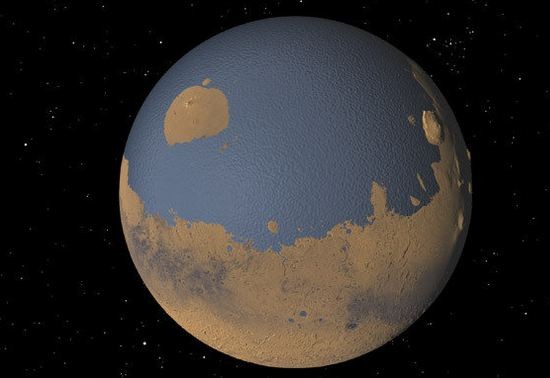It's hard conceiving of it now, but billions of years ago, Mars had an ocean so large it could have covered the surface of the planet to a depth of 137 meters, or about 450 feet.
Much of that ocean's water has dissipated into space since then, but its disappearance has heightened expectations among scientists that life might be hiding among the cracks and crevices that ancient ocean left behind.
NASA scientists say that after six years of painstaking observation, they've found convincing new evidence ancient Mars once had an ocean. They describe the ocean as probably the size of the Arctic Ocean.
The ocean on Mars mostly would have been located in the northern hemisphere, which is one to three kilometers below the surface of the southern hemisphere, scientists said.
NASA estimates the northern ocean would have covered some 19 percent of the Martian surface. In contrast, the Atlantic Ocean covers about 17 percent of Earth's surface.
"The existence of a northern ocean has been debated for decades, but this is the first time we have such a strong collection of data from around the globe," said Michael Mumma, principal investigator at NASA's Goddard Center for Astrobiology and an author of the report, published in the journal Science.
"Our results tell us there had to be a northern ocean."
He said measurements suggest an ancient Mars that had enough water to cover the planet to a depth of at least 137 meters. This is the highest estimate of the amount of water on early Mars that scientists have ever made, said The New York Times.
"The more water was present -- and especially if it was a large body of water that lasted for a longer period of time -- the better the chances are for life to emerge and to be sustained," said Paul Mahaffy, chief of the atmospheric experiments laboratory at the Goddard Space Flight Center.
Using powerful telescopes to measure water signatures in Mars' atmosphere, scientists estimated Mars in its infancy would probably have had an ocean more than a mile deep covering almost half of its northern hemisphere.
NASA scientists used the world's three major infrared telescopes (one at the W.M. Keck Observatory, the NASA Infrared Telescope Facility and the Very Large Telescope) to study water molecules in the Martian atmosphere.
Earlier findings from NASA's Curiosity rover suggest Mars had water 1.5 billion years ago, but this estimate will be pushed further back by the new findings, said CBSNews.
"With Mars losing that much water, the planet was very likely wet for a longer period of time than previously thought, suggesting the planet might have been habitable for longer," Mumma said.
Scientists looked at two slightly different forms of water, H2O and HDO, a naturally occurring variation of water in which one hydrogen is replaced by a heavier form called deuterium.
Unlike normal hydrogen that is lost to space, deuterium remains trapped in the Martian atmosphere.
They found the atmospheric water in the near-polar region was enriched with deuterium. This means Mars had lost a volume of water 6.5 times larger than the present polar caps.
They also estimate Mars has lost 87 percent of its ancient ocean to space and that the remaining 13 percent is likely stored in the polar ice caps. A likely location for this water would be in the Northern Plains.



























